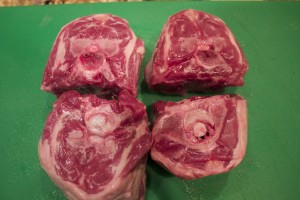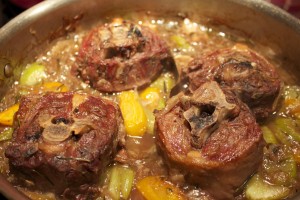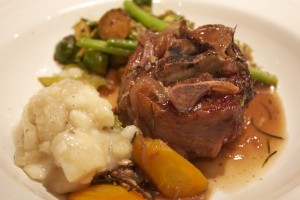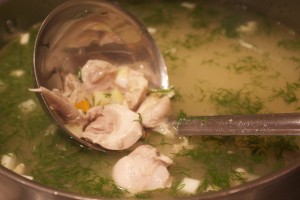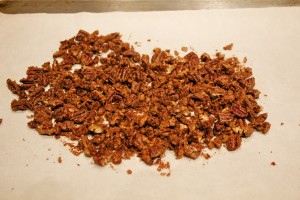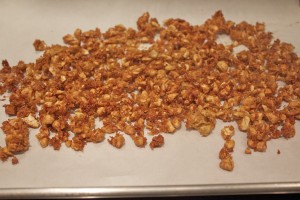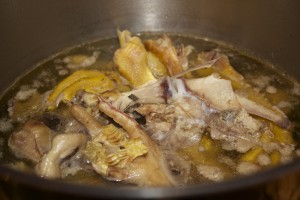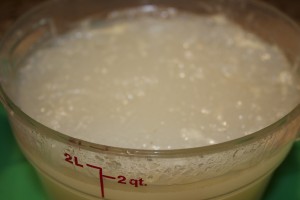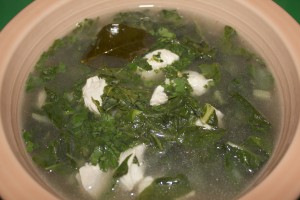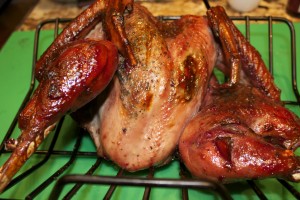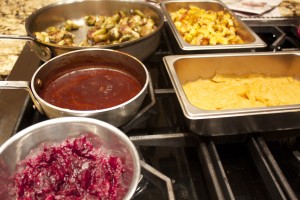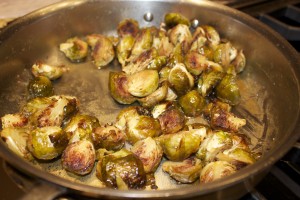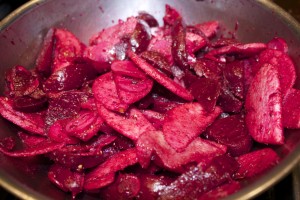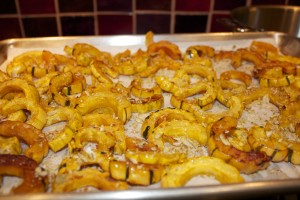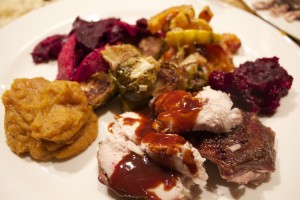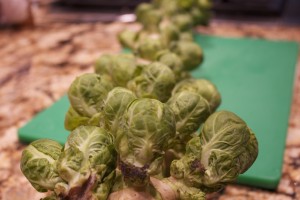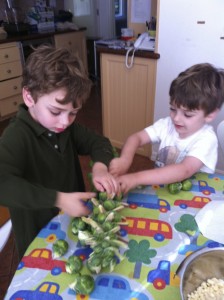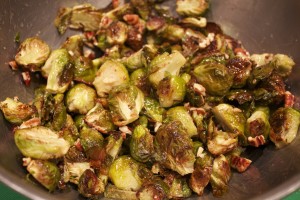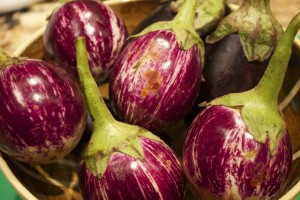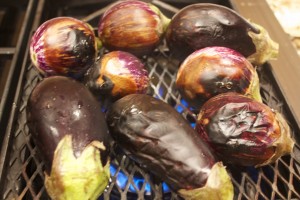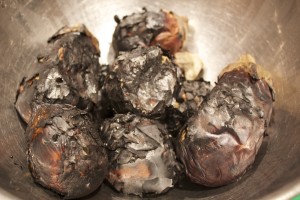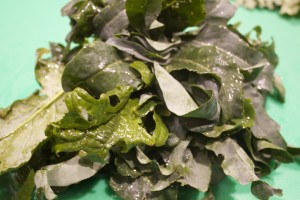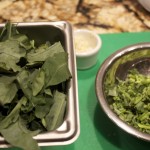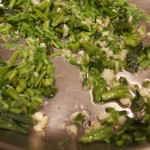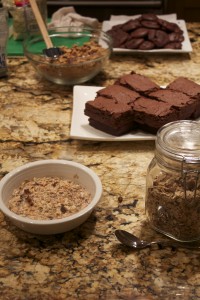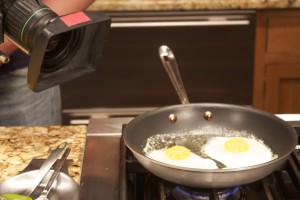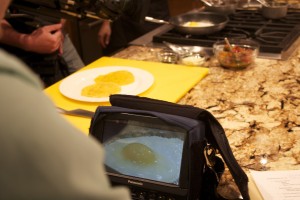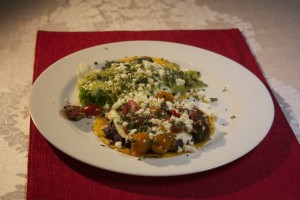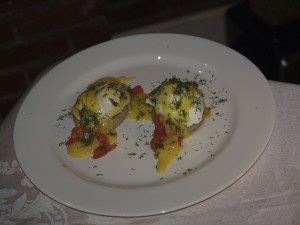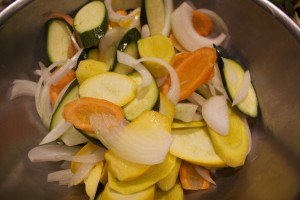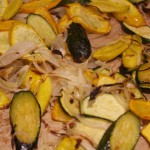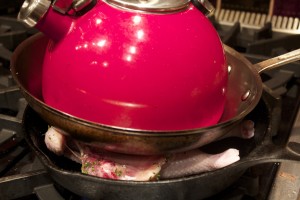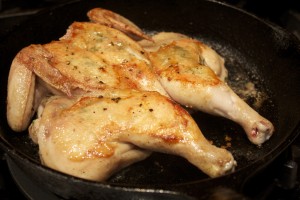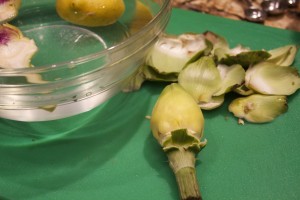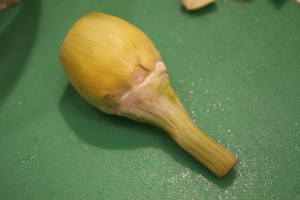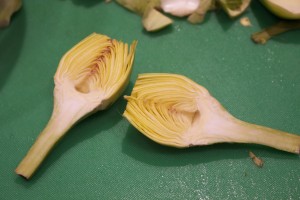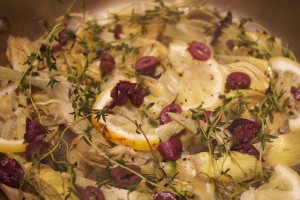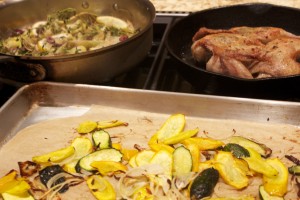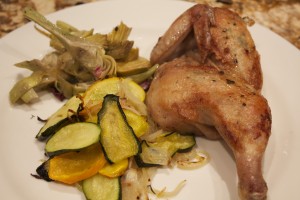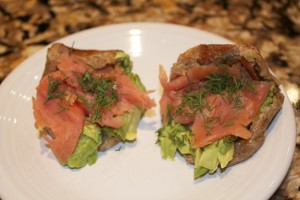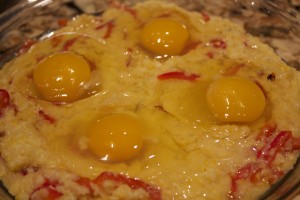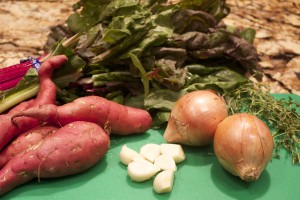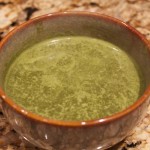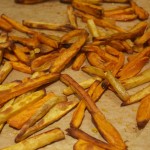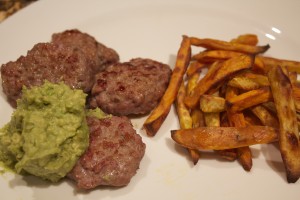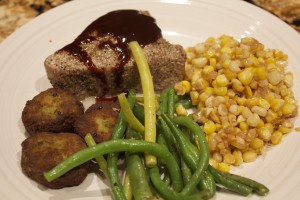
|
Slow Sunday Cooking Last week I luxuriated in a solitary Sunday, a day devoted to complete hibernation. I stayed up impossibly late the night before, slept well into the day, and turned off my cell phone and computer. I spent the entire day perusing a hard copy of the New York Times, just budging off the couch from time to time to tend to the dishes that I was slow cooking. The day before, from my local lamb farmer I had purchased lamb necks , which looked to me a lot like osso bucco. This cut I had never cooked before; I knew that, like a lamb shank, a long slow cook in the oven would coax out the flavor and cook the meat to falling-off-the-bone tenderness. This dish was perfect for my Sunday state of mind. An added incentive was that I had made some lamb stock from 5 pounds lamb bones a few days before, although chicken stock would have been delicious as well. I sprinkled the necks with salt and pepper, then browned them in a film of oil. I removed the lamb to a plate and added to the skillet 3 cups sliced onions, 6 whole garlic cloves, a few sprigs fresh thyme and rosemary, and a bay leaf. I let the onions cook until softened, about 10 minutes. I added 2 ½ cups lamb broth and ½ cup red wine, and let the liquid come to a boil. I then added back the necks, covered the skillet, and put it in a 325˚F oven for 2 ½ hours. After uncovering the skillet, I raised the heat to 500˚F for half an hour to brown the meat. By this time the necks had beautiful color and were perfectly tender. I removed the pan from the oven, removed the pieces to a plate, set the skillet on a burner, and raised the heat to high. I threw in a handful sliced celery and carrots, and simmered the broth uncovered for 10 minutes, until it was the thickness of gravy; I then returned the lamb to the skillet. I served it accompanied by mashed yucca, Brussels sprouts and green beans. What a soothing and delicious meal for a lazy Sunday. While I was braising the lamb, I also had a big pot of chicken stock bubbling on a back burner. The next day I sautéed a large array of vegetables: onions, carrots. turnips, celery root, parsnips and sweet potatoes until softened. I skinned some chicken thighs and poached them gently in the stock until tender. I added the vegetables along with fresh ginger and dill to the soup and then seasoned it. Three quarts were packed off to a friend who, fresh from surgery, needed good nourishment. Share on Facebook and Twitter | Dinner, ingredients, Kitchen Tips, Lamb, Main course, Recipes | No comments
Maple Sugar and Candied Nuts When I want to use a granulated sugar, I invariably reach for maple sugar as my first choice. This natural sweetener has a subtle maple taste, and works well in many recipes that call for granulated sugar. Maple sugar is simply maple syrup that has been cooked until the water in the syrup has evaporated off. The clumps that are left are ground into smaller pieces, then sifted according to size – powder, granules, or a combination of the two. Nothing is added during the processing.
Maple sugar is relatively expensive. However, when purchased from the source, shipping and all, it is considerably less expensive than purchasing it in a store. I get mine directly from Coombs family farms, a wonderful sugar plant based in Vermont. Their phone number is 888 266-6271 and their website is Coombsfamilyfarms.com. They ship quickly, and you can purchase a choice of maple granules, powdered maple sugar, or a combination or the two. I use the maple powder for all of my maple sugar recipes, since this grind is the most like granulated sugar.
This morning I made a couple batches candied nuts to give away. I love candied nuts. When you make them yourself, you can use just the right amount of high quality sweetener to enhance great nutty flavor. A sprinkling of these crunchy nuts add so much pizzazz to hot breakfast cereals, desserts, salads and soups. They stay fresh in the pantry for two to three months, making them wonderful hostess gifts and edible presents. Bundle them in festive party bags for a treat that everyone will enjoy.
Here are a couple of my favorite combinations. These recipes both take a minimum of prep time and the oven does most of the work. Watch the video on how to make candied nuts. This first recipe is for candied pecans. I toss one cup roughly chopped pecans with 2 tablespoons maple syrup and 2 tablespoons maple sugar. I spread them on a parchment-covered baking dish and place them in the oven for 20 minutes. I stir the pecans one time during the baking, so that they caramelize evenly. The pecans are ready when they are dry all the way through. This technique works well with chopped walnuts, almonds, and blanched hazelnuts as well. When I remove the pecans from the oven, I let them cool before packing them. These pecans keep covered, at room temperature, for two to three months.
The second recipe is for coconut cashews, one of my favorites. The mix is an exciting combination of sweet, spicy, and crunchy, which makes, among other uses, an excellent garnish for a zesty carrot soup. I toss together in a medium bowl one cup of roughly chopped cashews, ½ cup unsweetened coconut, 1/3 cup maple sugar, ¼ teaspoon salt, and ¼ teaspoon cayenne. I then add one egg white to bind the whole mix together. Again, I’m spreading it on a parchment-covered baking sheet and baking it for 15 to 20 minutes at 325˚. I have to stir this mix twice during the baking session to ensure that the more delicate coconut colors evenly. (By the way, I pull out my tray to stir the mix, so I don’t lower the temperature of the oven. Then I return the tray to the oven to finish baking.) When the mix is evenly browned, I remove the tray from the oven and let it cool to room temperature. I break up the clumps into small clusters that are now ready to be stored or packed. Sweet holidays!
Share on Facebook and Twitter | Kitchen Tips, Natural Sweeteners, Recipes, Snacks, Where To Buy (Sources) | No comments
Chicken Soup I’ve been under the weather for the past few days with a full blown cold. This is unusual for me since I rarely get sick. When I feel the slightest bit of an impending sniffle, I have a coterie of preventative measures that I take, which usually work like a charm. I jump on my cellercizer (urban rebounder) to clean out my lymphatic system, I down Immune Response to strengthen my immune system, and I make an effort to get extra rest. This particular cold came on without much warning – it hit the throat first and then traveled to the lungs. I had a couple of energetic events to run, so there was no getting rest for a couple of days. Thus the full-blown cold landed Friday and ordered me to stop. It doesn’t make me feel better to know that colds are rampant this time of year, or that there is a particularly virulent strain going around. I am forced to finally and humbly surrender. I’m actually enjoying the enforced solitude and relaxation. Since my taste buds are depressed with the congestion, all I really feel like ingesting is hot soup. A good bone broth is just the elixir to drive away a fierce bug. So while I have been convalescing, I took out the stock pot, opened the freezer, and took out a big pile of poultry bones. I put up the simplest of stocks – bones, water, a splash of vinegar to draw out the calcium, and a bay leaf. That’s about as much effort as I could muster, and it took all of five minutes. The pot held backbones and wings from two chickens I had recently butchered, a turkey carcass, and a bag of chicken feet. I let this stock simmer about 6 hours, then I strained it, cooled it, and refrigerated it overnight. What made the stock especially gelatin rich was the bag of chicken feet I had purchased at the green market the other day. Chicken feet are hard for a lot of us to get used to, as yes, they are kind of creepy and freaky-looking bobbing around in your stock. Get over being squeamish, and you have a flavorful calcium-rich stock that’s great for your bones. Look at how gelatinous (translate: wobbly) this stock is after cooling. All I did was scrape away the top layer of fat. This is nutrient-dense goodness. For my soup today, I simmered a quart of the stock with some sliced shallots, some chopped ginger, and chopped lemongrass for about 15 minutes. I strained the stock, then added some coconut milk, boneless chicken breast cubes, and a small handful kaffir lime leaves that I had frozen. When the chicken was cooked after five minutes, I added a handful of Swiss chard, a splash of Thai fish sauce, couple of tablespoons lime juice, and a pinch salt. In my soup bowl I sprinkled chopped jalapeños and cilantro. The soup was delicious, and I’m feeling a lot better already. Share on Facebook and Twitter | Dinner, Kitchen Tips, Musings, Pantry Items, Soups | No comments
Wednesday Night Thanksgiving Even though the family was going out for the Thursday Thanksgiving meal, I still felt that yearly drive to make a whole turkey with lots of sides. It’s not important to me exactly which day I cook, as long as it’s around the holiday. The local farmer from the food club that I belong to had beautiful pasture-raised turkeys, so a friend and I decided to cook Wednesday, and have a mini celebration one day before the holiday. We split all the dishes we made – she had enough for her family the next day, and we had enough for one full meal of leftovers, which my husband and I enjoyed for lunch today. I had picked what vegetables looked good at the greenmarket, and we improvised a bunch of easy-to-make sides to go along with our beautiful turkey. Our turkey was small, about 10 pounds, perfect for about ten people. Tuesday night I chopped a couple tablespoons sage and mixed it with about a tablespoon of salt. I butterflied the turkey (I set aside the backbone along with the neck for stock), and slipped the sage-salt mixture under the skin. I sprinkled salt and pepper over the outside. I set the turkey on a rack in a roasting pan breast-side-down overnight. I took the bird out of the refrigerator an hour before baking and brushed the back with olive oil and added a couple cups water to the roasting pan. I roasted it at 350 for about an hour, then flipped the bird using wadded up aluminum foil, and cooked the bird another ½ hour. I then brushed it with cranberry glaze (made from 1 cup of cranberries cooked with ½ cup maple syrup and ¼ cup rice syrup until the cranberries burst.The mix was then strained.) I returned the turkey to the oven for 10 minutes, then added more glaze and roasted it another 15 to 20 minutes, until the temperature of the thigh was about 180˚F. I added water to the bottom a couple of times to keep the juiced from burning. The result: a beautiful deep red turkey – juicy and flavorful.
Gravy: I deglazed the pan with turkey stock (the neck and backbone I cooked in about 4 cups water for an hour while the turkey was roasting.) with about ½ cup of red wine. I made a roux of 2 tablespoons butter and 2 tablespoons flour cooked until light brown. I added the liquid and cooked it until thickened. The gravy was delicious – a deep red brown with hints of cranberry flavor. Cranberry sauce: I simmered 2 cups cranberries with the juice of one orange and 1/3 cup maple sugar. I added a splash brown rice vinegar and a teaspoon fresh thyme. I baked sweet potatoes (3 cups flesh), scooped them out and added a jar (1 ½ cups) chestnuts, ¼ cup butter, 1 tablespoon brandy, splash roasted vegetable stock to thin, salt, butter, and sprinkle of nutmeg, and puréed the whole lot. I roasted Brussels sprouts with extra virgin olive oil and salt for twenty minutes at 375˚F. I added a couple tablespoons butter with a small scoop mustard and about a cup roasted vegetable stock to a skillet. The mix was cooked until it reduced to a glaze, then the Brussels sprouts were stirred in.
Beets: Beets were roasted in the oven for about 2 hours, then mixed with thinly sliced Asian pears, thinly sliced radishes, 1 teaspoon ground star anise and 1 teaspoon coriander warmed with 2 tablespoons extra virgin olive oil, 2 tablespoons aged balsamic vinegar, salt and black pepper.
Delicata squash: Half rings were roasted with extra virgin olive oil and salt at 375˚F, then drizzled with pumpkin seed oil, lime juice, cayenne, and crushed pumpkin seeds. It was loads of fun – and good therapy too – hanging with a friend and cooking the day away. You don’t have to have a huge gathering to enjoy a delicious feast! Share on Facebook and Twitter | Dinner, Main course, Sauces, Side Dishes | No comments
Seasonal Vegetable Dishes from Union Square Greenmarket Last week was beautiful at the Union Square greenmarket. The whole stalks of Brussel Sprouts were too enticing to resist, so I bought a whole stalk. I’m not the only ones enamored with snapping off the the nuggets from the stalk. Over the weekend, the little nephews had a wonderful time snapping off the sprouts as well. I halved the stalks, tossed them with extra virgin olive oil and salt, and roasted them at 375˚ for 20 minutes. Meanwhile, I made a quick glaze of maple syrup, mustard, and butter that I heated on the stove. I tossed the Brussels sprouts with this mix and sprinkled the whole lot with chopped pecans. It’s nearing the end of eggplant season as well, so I purchased these miniature varieties and roasted them on the my chile grate (these grates are wonderful for roasting multiple vegetables at once.) I like the chile grate especially for small chiles and eggplants, since they don’t fall into the open flame. The smokey flavor of eggplants cooked directly over the fire is irresistible. After I covered them and let them cool a bit, I scraped off the skin, chopped the flesh, and mixed them with tahini, lemon juice, garlic, parsley, and pomegranate molasses. I served the chunky dip on rye bread from Rui’s, a fairly new Friday and Saturday Union Square Greenmarket addition. These guys make traditional hearty, delicious Scandinavian (100 per cent) rye bread. I also picked up an interesting vegetable called spigariella. It actually is a kind of broccoli without florettes, and tastes like a sweeter version of broccoli raab. It cooks in just minutes. I cut off the stems and cooked them first with garlic, olive oil, and red pepper flakes.
Share on Facebook and Twitter | Greenmarket Bits, Greens, ingredients, Side Dishes, Vegetables | No comments
Camera in the Food For nine hours last Tuesday I had a camera crew in my kitchen with a large video camera pointed at food that I was preparing. This was PR for the Natural Gourmet Cooking School. The Sundance Channel is doing a series called Love/Lust and the food that they shot in the kitchen was from the chocolate and the breakfast episodes. They will have people on camera speaking about various aspects of chocolate – history, cultural impact, etc. while they show shots of chocolate melting or baking or being spooned into champagne glasses. On camera I made four chocolate desserts as well as seven breakfasts. Chocolate desserts included chocolate mousse, chocolate lava cakes, brownies, and cloud cookies. Breakfasts included hot cereal with sautéed apples, muesli, granola, frittata, classic eggs benedict, a variation of eggs benedict, and huevos rancheros. Some of these were their choices, some mine. Preparation for the shoot was time-consuming. Mousse, for instance, needs a couple of hours to set, so I had to have a back-up made as well as berry sauce and whip cream so they could film the parfait being layered. I had to have two batches of brownies made in advance, as well as one batch of cloud cookies ready to go, because the cloud cookie batter needs to sit for an hour. The only dessert that was made and completed on camera was the souffle cakes. I did have the raspberry sauce and the whipped cream made beforehand, however. 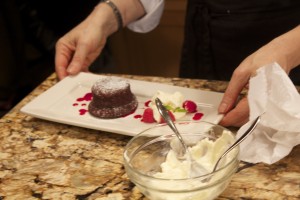 Freshly Made Lava Cake with Raspberry Sauce and Whipped Cream As for the breakfasts, I made in advance a batch of granola, I had muesli all ready to soak, I had salsa and beans prepared for the huevos rancheros, and I had spinach, mushrooms, and cheese ready to mix into the fritatas. I made three hollandaise sauces that day, so I had to have plenty of clarified butter as well. The actual cooking for the camera was not difficult once everything was in order. It was really interesting to look into the monitor and see what the high definition screen saw. Look at this egg compared to what was in the pan! So close; the human eye just doesn’t see food that way. They took many close-ups of chocolate melting, of chocolate oozing out of the cake, of bacon frying, and of eggs cooking. After each dish was completed they brought the dish over to a table and took “beauty shots.” The day was one of slow and painstaking work. It was interesting, however, and we churned out some tasty food. I’m certain that on the shows the food will be presented in quick fragments. I’m now wild for muesli and this variation of eggs benedict that includes smoked salmon and artichokes in lieu of the English muffin and bacon. The variation on the classic eggs benedict was a delicious dinner that night. Share on Facebook and Twitter | Breakfast, Chocolate, Happenings/Events, Musings | No comments
Fast but Unhurried I was leaving on a vacation last Thursday, so I wanted to make use of the beautiful vegetables that I had acquired on a pre-hurricane buying frenzy. My only new purchase at Union Square greenmarket Wednesday was a Cornish hen sized perfectly for two. Ben, the proprietor of Garden of Spices, has the tastiest pastured hens I’ve ever come across. I had a few baby artichokes as well as some yellow and orange carrots, zucchini, onions, and fresh thyme left over that I didn’t want to spoil. My meal thus had a focus. I peeled and cut the carrots on a diagonal, sliced the onions along the grow lines, and cut the zucchini into slim diagonal slices. I tossed the vegetables with coconut oil and salt, and placed them in a 400˚F oven to roast. Twenty minutes later they came out beautifully cooked. Meanwhile, while the vegetables were roasting, I prepped the hen. I cut out the backbone, opened up the bird (in other words I butterflied it), slipped some thyme and salt under the skin, sprinkled the top with black pepper, and brushed the skin with extra virgin olive oil. I seared the bird over medium-high heat face down in a cast iron skillet, weighted the top with another skillet, and placed a teapot on top to make sure the hen was pressed against the skillet. Get creative here. You need to weight that bird so that the maximum surface area touches the skillet. This way the bird can brown evenly. Once the skin side was browned – after about 10 minutes – I flipped the bird and placed it in the oven to finish cooking. 1o minutes later the bird was cooked to perfection – only 20 minutes total from start to finish. Lastly, I started on the artichokes. I prefer baby artichokes to the larger ones most of the time (with notable exceptions, of course) since there’s no hairy chokes to remove. Here’s a step by step method of how to prep a baby artichoke: Have ready a bowl of acidulated water (that’s water with a lemon squeezed into it) for the prepped artichokes, to keep them from discoloring. First, peel the layers of leaves off one by one until you strip the vegetables down to where yellow-green leaves cover the artichoke (except for the tip). Use a Y-shaped (the wide kind) peeler to peel off the tough green part around the base as well as the layer covering the stem. Cut off the tip. (A serrated knife works well for this.) Slice the artichokes in half and place them in the water as you finished prepping each one. I prepped six artichokes for the two of us. I then sliced the halves into several pieces, and placed them in a skillet with a dash of water, olive oil, salt, lemon slices, and thyme branches. I covered the skillet and steamed them for about five minutes, then uncovered the pan and cooked them a few minutes more. I then tossed in a few sliced kalamata olives.
Share on Facebook and Twitter | Dinner, Main course, Recipes, Side Dishes | No comments
Hurricane Sunday Comfort Food Hurricane Sunday was nursery night all day. We stayed in cozy clothes and ate breakfast for every meal. A couple of noteworthy highlights: Mochi with avocado, smoked salmon, and fresh dill. Mochi recently came back on my radar. The sticky pounded rice squares are available in the refrigerator section of natural food stores. Cut off a square no bigger than 2×2 and bake it at 450˚F for 10 minutes, until it puffs. A toaster oven works just fine. Slice open a pocket and fill it with whatever you like, then make sure to eat it while it’s hot and gooey. Another favorite combination is mochi (raisin-cinnamon) with almond butter and sliced bananas with a drizzle honey. Supper continued in the breakfast mode: Baked eggs with Fresh Corn Polenta I pureed the kernels from a couple of ears corn, sautéed them in a little butter, then added about ¼ cup of corn grits, ¼ teaspoon salt, and a cup water. I cooked it in a medium skillet, stirring frequently, for about 5 minutes, then stirred in a sliced roasted red pepper. I transferred the whole corn mass to a pie plate, made a few craters, and cracked an egg into each indent. I sprinkled a lttle salt over the eggs along with a few drops water, and baked them in a 350 degree oven for about 25 minutes. Seriously delicious. Share on Facebook and Twitter | Breakfast, Corn, Dinner, Eggs, ingredients, Main course, Recipes | No comments
Night Before Irene We were among the lucky to have been in Manhattan during hurricane Irene. Still, we didn’t know how hard the storm would hit, but we did know the city would shut down public transportation as of noon on Saturday. It seemed wisest to stock up with eatables. Everyone seemed of the same mindset; the markets on Friday afternoon were teeming, and rumors circulated at Union Square that the greenmarket would be closed on Saturday. Half of the farmers did show up, however, and they did brisk business. Hats off to those intrepid farmers. It was a good weekend to attend to some home projects without the guilt of feeling I should be out and about. I wanted our food to be quick and comforting – and, of course, delicious and nutritious. The menu: Purée of Swiss Chard soup, roasted sweet potato fingers, and turkey sausage with avocado mustard. Purée of sweet potato soup: I sweated a couple cups onions in olive oil, then added half a dozen peeled whole garlic cloves, a dime’s thickness of fresh thyme springs, a couple of peeled fingerling potatoes, teaspoon salt and a quart of chicken stock that I had from one of my favorite greenmarket purveyors (Garden of Spice, which are at the Union Square on Wednesdays). I let the soup simmer partially covered beautiful chard (stemmed) and let it wilt in the hot soup for a couple of minutes. I blended the soup, put it back in the pot, added a squeeze of lemon, a sprinkling black pepper, and adjusted the salt. Meanwhile, I roasted these sweet potatoes (mix of white and orange) in virgin coconut oil and salt. Coconut oil gives the sweet potatoes a delicious buttery flavor. I smashed an avocado with a dollop of Dijon mustard and cooked up sweet turkey sausage from Di Paulo farms. The sausage is beautifully spiced and ready to cook. Everyone loves it! http://brooklynbased.net/email/2010/11/where-to-get-your-gobble-gobble/. (This link has a description of the poultry farmers at Union Square. Not all have websites. The link also includes some purveyors that ship pasture-raised poultry.) It was a casual and satisfying meal on the eve of an impending storm. Share on Facebook and Twitter | Dinner, Greenmarket Bits, Recipes, Where To Buy (Sources) | No comments
Olive Oil Poached Tuna I had corn left over from the duck confit meal, and I had edamame cakes that I had previously frozen, so I decided to work my dinner around those. Since I was near Chelsea Market, I stopped in The Lobster Place (lobsterplace.com/), one of the best fish markets in New York City. I picked up a couple of gorgeous chunks of tuna to poach in olive oil that I had already in my refrigerator. You can oil poach with tuna, salmon, halibut, and shrimp, and use the oil as much as four times. Don’t worry – the oil doesn’t smell, because you are heating it to 120˚F, which is really low. The oven is heated to 225˚. You need a thermometer – a probe is the best variety. I have a Poulder, but any type is good. You need to have enough oil in the pan to be able to immerse your fish in oil and your skillet should have straight sides. I rubbed the steaks with a combination of salt, pepper, and ground fennel. My refrigerated oil looked solid (extra virgin olive oil is a monounsaturated fat, which goes semi-solid when cold) but it quickly melted over low heat. As soon as the oil had melted, I added the thermometer. I hold back on some of the oil, because it is easy to overshoot the 120˚F. When that happens, I can add a glob of cold oil and lower the temperature quickly. Otherwise, I simply wait for the oil to cool until the proper temperature. Add the fish (make sure it’s completely immersed) and place the skillet in the oven for 25 minutes. When ready, remove the fish and strain the oil. I served the fish with the following recipe for Teriyaki Ketchup from my book The Healthy Hedonist. In the book it’s paired with a tuna burger. 2 tablespoons shoyu (natural soy sauce) 1/4 cup sake or mirin (substitute with dry sherry) 2 tablespoons maple syrup 2 teaspoons tomato paste 1 teaspoons dijon mustard
Share on Facebook and Twitter | Dinner, Fats & Oils, Recipes, Sauces | No comments
|
